Ellen and Jim Have a Blog, Too
We are two part-time academics. Ellen teaches in the English department and Jim in the IT program at George Mason University.


A revised concise summary of the Palliser films, 1:1-2:4 · 21 November 07
Harriet,
I’ve decided to put a concise revised summary of Volumes 1 and 2 (Parts 1 through 4) of the Pallisers on this blog space today. I link in summaries of 3:5 and 3:6. Tomorrow I’ll provide an essay for the summary on Volume 3:5. I’ve given each part an appropriate thematic title or titles.
The part divides into 5 episodes, and within these there is much parallelism and contrast. The part is highly theatrical & pictorial.
Episode 1: “Plantagenet’s friend” is Griselda, Lady Dumbello. The scenes between Plantagenet and Griselda are sandwiched in between scenes of the Duke offering Plantangenet much money and favor and scenes of George Vavasour and Dolly Longstaffe talking about them and also Glencora and Burgo.
Episode 2: “Glencora and Burgo.” Their story is presented marvellously effectively as a sort of dance. Waltz music plays throughout and we watch the young pair waltz. We can see their love affair can hardly continue as their scenes are juxtaposed byo two sets of choral conversations filling us in and setting the framework: again George Vavasour and Dolly Longstaffe; and the hard mean pair of aunts (presented I’m afraid as harpies in black), Adelaide, Marchioness of Auld-Reekie and Charlotte, Countess of Midlothian on the other. The minds of these two women are presented as a sink of filth: at one point one suggests another man for Glencora; they whipser leeringly into one another’s ears and decide, well no. The attitude towards sex in this pair is vile.
Episode 3: “The Duke’s wishes.” The Duke is against Plantagenet’s possible liaison with Griselda, Lady Dumbello because (it’s hinted) he, the Duke, had an affair with Lord Dumbello’s mother, Lady Hartletop. (In The Small House Trollope hints that Lord Dumbello is the Duke’s illegitimate son.) This episodes climaxes on the Duke’s secretary Fothergill warning Plantagenet that if he displeases the Duke he, Plantagenet, could lose all the favors and heaps of money the Duke is ready to bestow on him. The scenes showed why the woman is confrontationally bullied: in a sense that’s all Lady Glencora’s aunts have is intense harassment and overt personal bullying and cruel comments; the Duke behaves far more respectfully to his nephew, but he has far more ultimate effective weapons since Plantagenet wants to have an effective role in public life.
Episode 4: “Going to Alice’s.” Alice Vavasour is brought in and this time by going very slowly I could see the film-makers meant us to see that her failure to help Lady Glencora (as Lady Dumbello fails Plantagenet) is partly the product of her own sexual betrayal by George.
Episode 5: “The engagement.” Through an extraordinary series of tracking shots we watch Plantagenet and his uncle walking through a series of trees from one end of a park, and Lady Glencora walking with her aunt through another. They walk very slowly. When they reach the clearing, the young couple must walk to one another and then plight their troth. It is an unforgettable theatrical ring scene sandwiched between the corruption of the aunts and uncles as both sets counsel adultery.
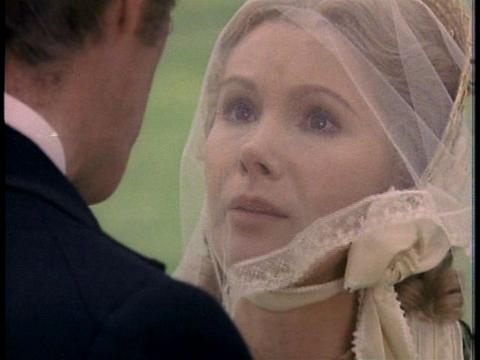
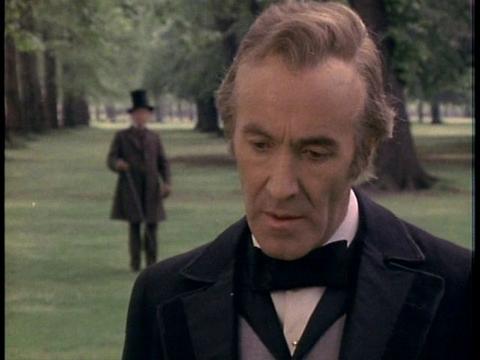
Plantagenet Palliser (Philip Latham) and Lady Glencora McClusky (Susan Hampshire) pressured into a bethrothal, closing stills
*****************
1:2: “How can people fulfill themselves?” (this and the above part can also be called “Coercion and Pursuit”).
Episode 6: “The Wedding.” We see the coerced terrible moment, all pomp and misery; a juxtaposition of Burgo and George at the Club as at a death of a dream; Plantagenet and Lady Glen on the sleigh; and finally, Alice and her father, John, waiting for Kate and George to arrive to go to Switzerland.
Episode 7: “Switzerland.” On the terrace are Alice and her father and and Kate; then Alice and Grey. Lady Glen and Plantagenet arrive at the hotel, and we seed Lady Glen’s dismay at the plans Palliser has for the honeymoon (meeting bankers and going to museums, seeing the landscape); we see his strained cheerfulness and patience. George arrives, and Kate and George plot against Alice, and we find ourselves again on the terrace, with Alice and George over a telescope dreaming of adventure. Lady Glen gets letters from Burgo, tears them, spies Alice and the two groups meet and become one. Lady Glen proposes a trip to fencing school proposed; she hopes to send Palliser and John Vavasour off to museum, but (i a comically tragic scene), she discovers that the museum is closed and Palliser, ever gentle and accommodating, proposes to go with her to the fencing school.
Episode 8: “Fencing.” Burgo confronts Lady Glen as fencer, and there is a scene where she draws close to him which visually repeats the ring scene of her engagement to Palliser: She is pulled away, rescued by Palliser. Then we watch George and Alice on the terrace the night before leaving Switzerland. Kate has left them alone (she will pack). This is a powerfully romantic scene where George proposes intense excitement as a candidate Alice can back; reminds her of how he was like brandy (John Grey is a glass of milk), to which she says yes but the glass is poisoned by its vile contacts (and George’s attitudes):
They are fencing too.
Episode 9: “Glencora adjusts.” It opens with a comical yet nasty & sombre scene where the Countess of Midlothian (Fabia Drake) and Marchioness of Auld-Reekie (Sonia Dresdel) inform the Duke of Omnium (Roland Culver) that Burgo has been pursuing Lady Glen (he “sprang out like a demon king in the pantomime”) and they fear she will run off with him; the Duke shrugs it off, with the statement the lady must be taught not to make her messes on the rug and provide an heir and spare first.
We then Lady Glen glimpsed imprisoned behind the Matching Priory barred windows; we have her scene with Plantagenet where it emerges she cannot easily take over making even the guest list as she doesn’t know enough, and her competition with the insinuating labor politician, Mr Bott. At Ely Grey asks Alice to name a date, pick material for their house furnishings; she begs for time and he says she’s ill.
Episode 10: “A New Candidate.” Now the politics of the film cycle begins to emerge powerfully. We first see George and Burgo at the club drinking, and this scene gives way to Barrington Erle and Dolly Longestaff discussing how acceptable Vavasour is (they will have to look into this). Then there is the election scene at the pub and back room between Grimes, Scruby and George. Back at Matching Priory Palliser disapproves of Lady Glen reading Balzac (and Mr Bott wins a round), but as he sees, she cannot find anything to do wth her life, and needs something real and meaningful, he encourages her to bring Alice out of real sympathy for her. There is apparently a growing affection for her.
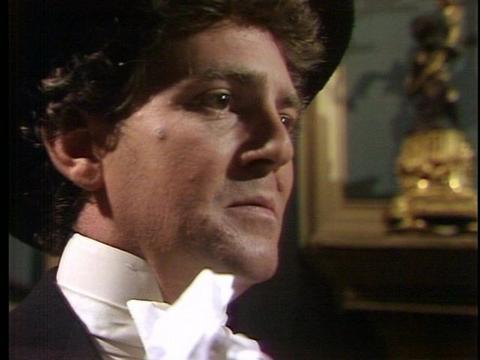
Burgo Fitzgerald’s (Barry Justice) crazed desperate face at the part’s close
**************
2:3: “The Splendours and Miseries of Courtesans” (includes “Burgo and the Beggar Girl”).
Episode 11: “Alice Visits.” The long carriage ride (referred to above) of Alice and Lady Glen through a lovely autumnal landscape and the splendid property of Matching Priory, a country house given them as a first present by the Duke for having married. A key speech by Lady Glen anticipates the joyous moment of Part 25 when we see her driving four with her two sons, Madame Max and daughter behind her. Alice is greeted by Mr Palliser warmly, and meets (as do we for the first time), the Duke of St Bungay whose importance is signalled by conversation which shows how quickly a friendship between him and Lady Glen has formed. Lady Glen snubs Mr Bott, and the Duke is amused.
There follows the first confidant scene between Alice and Lady Glen in Lady Glen’s beautiful boudoir room, one rich with history in the Jacobean ceiling and old church-like windows. The scene is juxtaposed to one of Burgo and George playing backgammon; they discuss George’s correspondence with Alice from which he says he learns nothing to Burgo’s purpose about Lady Glen. A third confidant scene, ugly with seething envy and manipulation between the Ladies Midlothian and Auld-Reekie. Of interest is how the camera moves from Alice’s tight face refusing to speak of Burgo in London to Lady Glen, to George and Burgo’s faces over their game (“Dealers’ last?”), to Burgo’s hands playing with the dice to the two old women’s bejewelled hands.
Episode 12: “Entertaining.” Alice in the vestibule before entering the Palliser salon. She looks at her dress, stiffens herself, puts her hands in front, holds her head a little higher, hesitates before the door. We watch a long scene of politicking where we see Mr Bott left out, and how Barrington Erle (Moray Watson) functions as a mouthpiece for the average point of view (complicit, approving) of what is seen to happen. Then a second confidant scene between Alice and Lady Glen (quoted from above), juxtaposed to another of Burgo and George, now at billiards, where we see George somewhat generously willing to fund Burgo (it’s not clear that Burgo will be able to do anything for him if he runs away with Lady Glen), although it seems George must borrow from Jewish ursurers for any funds. This 12th episode culminates in the moving street scene between Burgo and the female beggar.
Episode 13. “Meddling Again.” Lady Glen reading in her boudoir with Alice some of the most highly sexualized lines in all Tennyson, lines which evoke mirth from the two young women. Palliser comes in and (naively) rejoices at what he perceives as innocent laughter; he is also glad to see his wife cheerful. The next scene that ensues, though, is not pleasant: he insists they go to Monkshade and, despite his asseverations to the contrary, is well aware that his wife’s previous engagement to Burgo “signifies.” Juxtaposed to this scene is a still of Mr Bott salaciously enjoying Splendors and Miseries of Courtesans, preparatory to his insinuating nagging of Alice as (in his mind) no less a prostitute than himself. Then the direct (and yes nagging) challenge of Lady Midlothian to Alice, Alice’s second distress before Mr Palliser (she is disturbed far more by Lady M than Mr Bott, this drives her to reject Mr Grey), Palliser’s stern disapproval of the plan to go to the Priory and seething refusal to “forbid it.”
The 13th episode climaxes in a new pair of confidants: Burgo and Lady Monk plotting against Lady Glen. Lady Monk is dressed in the same dark emerald shade of green as Lady Midlothian. As Burgo lays back on a couch dreaming of how Lady Glen “will melt under his hands” (to use his phrase from the last scene of 1:2), we hear a hollow night-time ringing of priory bells, and the scene dissolves into
Episode 14 called “Lady Glencora’s Illness” to emphasize that one of Lady Glen’s aims in going into the priory was to become too sick to go to Monkshade. There’s a strong part of Lady Glen’s mind which tells her she must not melt before Burgo. She throws off her gauzy cape. The next morning Alice bravely tells an angry Mr Palliser he must not take Lady Glen to Monkshade. Departing in a striking way from Trollope’s text, Palliser retorts by asking Alice to leave the house (shades of General Tilney in Northanger Abbey). Thus in the next scene he can inform Lady Glen her confidant is gone, she is to get better and come down from her room, and go with him as this is her “duty” as his wife (Lady Midlothian used the word “duty” to Alice). A powerful set-to between the two of them ensues, fierce face to fierce face. He is now determined his will shall “overcome” hers. As he slams the door going out, we see her run to one of the windows that recurs and is a dominant motif as a beautiful caging in the series from 2:1 to the 26th part. The next scene we again see Alice’s father (most unlike Trollope’s Mr Palliser; see 1:2) waiting up for his daughter, affectionate, caring, and distressed over her breakup with John Grey. It is again made clear her decision was motivated by what Alice saw at Matching Priory.
Now a brief glance at Burgo and George at the club framed by a dialogue between the choral figure of Barrington Erle and Dolly Longestaffe (Donald Pickering). Dolly is begining to think George is “not sound” because he is spending too much time with Burgo Fitzgerald and “trying to raise money on Vavasour Hall” while “his grandfather’s still alive and kicking and the place ain’t even entailed to him.”
The penultimate episode concludes with George’s visit to Alice. It’s utterly different from Trollope’s presentation where Alice has no sexual desire for George whatsover and he is willing to take her money in her stead. They look longingly at one another, kiss, and she is mastered by him as well as anxious about how her father and grandfather will take the news.
Episode 15. “New Engagement.” Another snowscape, the outside of Vavasour Hall into which the camera goes to allow us to see a passionate family scene where Alice tells her grandfather (Donald Eccles) she’s broken with John Grey, and is engaged to George, his grandson; her father becomes livid with worry and his description of George is phrased so to the ears of the viewer it is also a description of Burgo. Alice maintains George has changed, Kate (Karin MacCarthy) says her uncle has been “too hard” on George, and when the grandfather speaks ferociously and utterly indifferently about George (again unlike Trollope’s novel, refusing to allow George to visit) because the grandfather fears George will spend all the property to feed his ambitions, we tend not to blame George. We remember Mr Scruby and Mr Grimes from 1:2. We have only seen George with his sister and Alice & as a figure in a male landscape whose normative figures are Longestaffe and Erle.
The part comes to a close at Monkshade where amid the company Lady Monk and Burgo await Lady Glen. After all, Palliser left her behind: his face is grim as (supported by the “faithful” Mr. Bott), he tells what he knows to be part lies: she was too ill. Burgo manages to behave civilly in response to Palliser’s offer of a handshake: Before the concluding shot of Burgo and Lady Monk replotting against Lady Glen’s peace, we get framing dialogues between the Duke of St. Bungay and Erle where Bungay characterizes Burgo as “reckless” & “rotten” and Lady Glen as the “sweetest girl that ever was” where sweetness appears to mean more than innocent and good, but socially “genial,” to Bungay’s taste, and Erle asks, “Yes, but does Palliser appreciate such sweetness, do you think?” A close-shot of a nervous-looking Palliser suggests that’s not what is the issue; the issue for him is his male pride and her safety (we might put it autonomy).
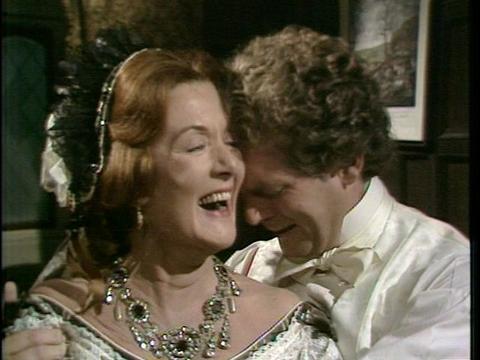
The last still: Burgo (Barry Justice) again, weakly despising what he’s doing, Lady Monk’s (Helen Christie) mean laughter
************
2:4: “The Crisis and a Choice Made”
Episode 16. “The Return to London.” Here we see Alice’s strong nature come out as she copes with her father’s adament condemnation of George and her grandfather’s needling words. Burgo and George are pictured together briefly: George tells Burgo there will be a bye-election and now he must have more money; he voices hesitation in taking Alice’s money which he sorely needs, and Burgo is the cynic: “Scruples, old fellow?” The title of the episode, The Return to London” highlights the scene of Lady Glen and Plantagenet coming back to their house. The establishment shot shows us a gorgeous room, much gold. Lady Glen is so relieved to be back, but Plantagenet utters a line from Wordsworth when he sees the letters on a table: “The world is too much with us.” He does not know the letter is actually from Burgo to Lady. The episode includes the first of the two brilliant scenes of Scruby and George, much of which is original invention on the part of Raven. Mr Scruby (Gostelow) just about never makes eye-contact with George (Watson): this is skilful ruthless bullying. You see it’s not Scruby’s fault this money is necessary.
Episode 17. “Alice’s Money.” The scene is Alice’s drawing room in London, the players George and Alice. Raven has transformed Trollope’s Chapter 35 (“Passion versus Prudence,” in the 1974 Penguin edition by Stephen Wall, pp. 375-80). Trollope’s Alice is appalled that George comes to her; Raven’s Alice is eagerly running to him at his steps. In Raven’s scene, Alice must tell George, Squire Vavasour will give no money to George, but settle the estate on her when they marry; she offers him money but puts off marriage and he is shamed and reluctant but gives in. This is followed by a scene between John Grey and Alice’s father, John Vavasour where Grey offers to put his money in place of Alice.
Again Raven has taken material from Trollope’s scenes but rearranged it; this time the emphasis is on Grey’s tenderness. The scene is then reinforced by another in Alice’s drawing room: a letter from Lady Glencora Palliser arrives in which Lady Glen has asked Alice to come to her, but her impulse to go to Lady Glen is forestalled when John Grey enters, she turns in a gesture of intense emotional distress before he comes in, but Grey is non-threatening, and their talk is genial, one of dear friends; the importance of his trust in her and respect for her, and his non-agressive sexually is shown in her face and gestures. In the next scene we have Lady Glen playing solitaire and given comfort by Alice’s arrival.
Episode 18. “Defending Glencora.” The one defending Glencora is not Plantagenet but Alice. The point of this episode or shaping idea is to contrast how Plantagenet has serious state business and Lady Glen none; Lady Glen has no sympathy or understanding of his aspirations. In the first scene we see Palliser triumph in speaking in Parliament against the Chancellor of the Exchequer and how he gains admiration and respect. He comes back to find her sewing the hair on a doll. She is infantilized, and they clash as he wants to invite Mr Bott for dinner but is still trying to control her by keeping Alice from her. The pre-dinner scene is important. Much strain and tension going on but finally put to rest by Plantagenet who concedes he has been at fault in blaming Alice. This is the scene where Plantagenet’s finer nature comes out (which I described above) and he owns himself to have been in the wrong.
Meanwhile George is elected and we see him in a scene of uproaring nonsense and noise at the pub, sandwiched between Mr Grimes and Mr Scruby who are prepared to fleece him again for the next one. Then a powerful scene with Alice where she at first succumbs to an intense sexual attaction to him. It’s important to remember that Trollope’s Alice is not attracted to George; Raven’s is and is contradictory in her impulses. Mr Vavasour comes in and tells of the grandfather’s illness; Alice must go to Vavasour Hall and thus will not be there in London for Glencora at the ball. Lady Glencora enters and is frightened to realize she will have to cope alone, decide alone.
Episode 19: “The Ball.” This is the height or climax of this episode and may be regarded as containing one of the pivotal climaxes of the whole series. Very effectively it opens on a gothic scene of Alice and Kate (Karin MacCarthy) at Vavasour Hall with Squire Vavasour.
And so by contrast and suggestive ironic parallels we reach Lady Monk’s ball. This is an electrifying series of vignettes arranged around the central ballroom. As the sequence of scenes opens, we are terrace and watching Burgo and Lady Monk: it’s hinted they may be lovers; he has the money from Lady Monk, and is ready to remove Lady Glen if she will go off with him. We then get a brief scene of Lady Auld-Reekie and Midlothian on the way to the ball: they are two spiteful hags in green. They have ruined Lady Glen’s chances for deep happiness and are going to the ball to make sure their tyranny sticks. Then we see Lady Glen, Palliser and Mr Bott mount the stairs and be pulled in by Lady Monk. Lady Monk is the great spider lady and when she appears whatever she approves of feels sinister and certainly something Lady Glen should avoid to keep her peace and sanity, let alone solvency.
There is a certain quiet but improbable comedy in the first phase of the ball as we are asked to believe that Palliser has no conception that Lady Glen is eager to dance and himself carries on a conversation with Mr Bott about politics, and oblivious to all around him. He leaves early, telling her only not to overheat herself. Burgo seizes his chance; Lady Glen sees him across the floor, and is partly driven out of resentment to accept his offer of a dance when her aunts come over and like dragon-ladies attempt to control her. Now the camera catches them dancing as other pairs look on and comment (as in Pallisers 1:1). The music is very Strauss-like and begins to play and continues to do so on and off for the rest of this episode. It’s a dance of life and despair: life for Burgo if he can capture Lady Glen (dressed in blue like a Cinderella princess. We are not allowed to forget the George-Alice story as among the pairs are Barrington Erle and Dolly Longstaffe who talk unsympathetically of how George is going to make his maiden speech very quickly.
Episode 20: “Burgo’s Plan.” The first scene is in Parliament and George is making a speech on behalf of the secret ballot and we can see Palliser approves of it and the house seems to cheer George’s candour and desire to free the process of bullies and corruption. But Palliser is interrupted by the well-meaning Mr Bott. We are to understand in the film that Mr Bott really means well. The camera brings us back to the ballroom and we catch Lady Glen and Burgo dancing and it is now that he reveals his plan. They flee her aunts to terrace; and then flee them back to the dance floor and the moment is over. Her conduct for the rest of the ball shows her to have less depth of feeling than Burgo. She spies Plantagenet on the stairs, and suddenly gains animation and confidence, and giggles (!); she plays the gay lady in a performative speech to Burgo as Palliser comes over. As she goes down stairs with Palliser she has chosen to walk with him, what the aunts wanted her to chose and as we see them go off the camera switches to the aunts in triumph. We see Burgo left standing there, with a look of sheer pure pain on his face, total desperation but an adult, someone free who would have acted had she had the courage to do with with him.
The concluding alternating scenes: the camera first catches Burgo’s feet walking on the cobblestones, then close-up to his face. He crosses the square and we glimpse a woman streetwalker. The camera then switches to Lady Glen in her bedroom, a ravaged child who clutches a doll. As the camera moves back and forth between Burgo looking up, and Lady Glen preparing for her bed, we realize he has walked to her window and is waiting outside. She cannot know he is there, but he is in her mind and heart. Voice-over from her mind: we hear Burgo’s eloquent plea (“you will be the wife of my body and my heart”) as we watch her face; she is hearing it in her mind’s brain. She turns out the light and gets in bed, lays there and then he hunches over and walk away. The series music is heard faintly and then resumes in full force.
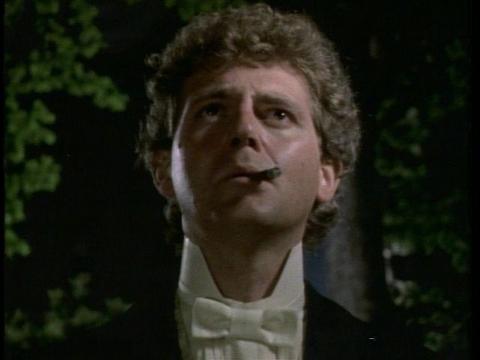
Again the last still of Burgo Fitzgerald (Barry Justice)
*************
Upcoming: Pallisers, 3:5, The back story about male outcasts; Pallisers 3:6: The story horizon is reconfigured
Sylvia
--
Posted by: Ellen
* * *
Comment
- I had the idea to look at what are the last stills in each episode,
and found that 3 out of the 4 end on the anguished face of Burgo Fitzgerald, sometimes shattered, sometimes sick with self-loathing and laughing at himself, sometimes just standing there. The fourth are the grieved faces of Plantagenet and Lady Glen look at one another for pity and companionship.
David Lean says the ending still is very important. This truth angers him for it’s the ending of a film a studio will often censor or change to be upbeat. They didn’t do this in the Pallisers as so many of the episodes end on an ironic or angry or depressed scene, or one which says life goes on as it has—a very mixed bag indeed.
Now the stills are important too, both the opening mise-en-scene of each episode and the close.
I’m developing the idea that each film playlet has a back story which is quite different from the front one’s emphasis, and these stills go far to demonstrate that the characters Raven cares for are the male outcasts, for these are the ones he recognizes himself in, identifies with. Samuel Johnson says the way to judge and understand a society is how it treats its powerless and most vulnerable. Gentleman may not seem our (or Trollope’s) idea of the powerless or most vulnerable, but not in Raven’s estimation. To him men have to endure cruelties analogous to those of women, especially of course gay men. He harps on the draft: how men are driven to become trained militaristically, put in these goddawful barbaric schools, and then drafted to kill or be killed.
At any rate Burgo and George are ejected basically because they are without money and connections. That’s how George becomes the prey of Scruby (played brilliantly by Gostelow) and how the Duke and his two hags so easily brush off the engagement of Burgo to Lady Glen.
Be it understood I am talking about Raven’s Pallisers, not Trollope’s novels.
E.M.
— Elinor Nov 22, 10:00am #
commenting closed for this article
